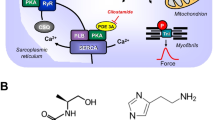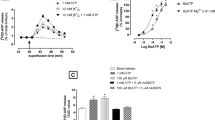Summary
The effects of histamine and related drugs on the evoked tritium overflow from superfused rat brain cortex slices preincubated with3H-noradrenaline were determined. Tritium overflow was stimulated electrically (3 Hz; slices superfused with normal physiological salt solution) or by introduction of CaCl2 1.3 mmol/l (slices superfused with Ca2+-free medium containing K+ 20 mmol/l).
Histamine slightly decreased the electrically evokedH overflow in slices superfused in the presence of desipramine. The degree of inhibition obtained with histamine was doubled when both desipramine and phentolamine were present in the superfusion medium (pIC15 6.46). Under the latter condition, the evoked overflow was inhibited by the H3 receptor agonist R-(−)-α-methylhistamine and its S-(+) enantiomer (pIC15 7.36 and 5.09, respectively), but was not affected by the H2 receptor agonist dimaprit and the H1 receptoragonist 2-thiazolylethylamine (both at up to 32 µmol/l). The concentration-response curve of histamine was shifted to the right by the H3 receptor antagonists thioperamide, impromidine and burimamide (apparent pA2 8.37, 6.86 and 7.05, respectively), by the H2 receptor antagonist ranitidine (apparent pA2 4.27) and was not affected by the H1 receptor antagonist dimetindene (32 µmol/l). The inhibitory effect of R-(−)-α-methylhistamine on the evoked overflow was also counteracted by thioperamide. Given alone, none of the five histamine receptor antagonists affected the evoked overflow. In the absence of desipramine plus phentolamine, impromidine and burimamide facilitated the electrically evoked3H overflow whereas thioperamide had no effect. The facilitatory effects of impromidine and burimamide were abolished by phentolamine, but not affected by desipramine. The concentration-response curve of noradrenaline for its inhibitory effect on the evoked overflow was shifted to the right by impromidine and burimamide, but not influenced by thioperamide (apparent pA2 5.24, 5.04 and <6.5, respectively; experiments carried out in the presence of desipramine). In slices superfused with Ca2+-free K+-rich medium containing tetrodotoxin, desipramine plus phentolamine, the tritium overflow evoked by introduction of Ca2+ was inhibited by histamine; the concentration-response curve of histamine was shifted to the right by thioperamide.
The present study shows that the inhibitory effect of histamine on noradrenaline release in the rat brain cortex involves presynaptic H3 receptors and that the degree of inhibition is increased in the presence of phentolamine. The H3 receptor antagonists impromidine and burimamide are weak α2-adrenoceptor antagonists.
Similar content being viewed by others
References
Arrang J-M, Garbarg M, Schwartz JC (1983) Auto-inhibition of brain histamine release mediated by a novel class (H3) of histamine receptor. Nature 302:832–837
Furchgott RF (1972) The classification of adrenoceptors (adrenergic receptors). An evaluation from the standpoint of receptor theory. In: Blaschko H, Muscholl E (eds) Handbook of experimental pharmacology, vol XXXIII. Springer, Berlin Heidelberg New York, pp 283–335
Göthert M (1979) Ca2+-induced noradrenaline release from central noradrenergic neurones promoted by high K+ concentration or ionophore A 23187. Naunyn-Schmiedeberg's Arch Pharmacol 307:29–37
Schlicker E, Hinterthaner M (1989) Histamine H3 receptor-mediated inhibition of noradrenaline release in the rat brain cortex. Naunyn-Schmiedeberg's Arch Pharmacol 339 (Suppl):R 90
Schlicker E, Betz R, Göthert M (1988) Histamine H3 receptor-mediated inhibition of serotonin release in the rat brain cortex. Naunyn-Schmiedeberg's Arch Pharmacol 337:588–590
Schwartz J-C (1988) Histamine receptors in brain. ISI Atlas Sci Pharmacol 2:185–189
Starke K (1981) Presynaptic receptors. Annu Rev Pharmacol Toxicol 21:7–30
Starke K, Göthert M, Kilbinger H (1989) Modulation of neurotransmitter release by presynaptic autoreceptors. Physiol Rev 69:864–989
Taube HD, Starke K, Borowski E (1977) Presynaptic receptor systems on the noradrenergic neurones of rat brain. Naunyn-Schmiedeberg's Arch Pharmacol 299:123–141
Van der Werf JF, Bast A, Bijloo GJ, Van der Vliet A, Timmerman H (1987) HA autoreceptor assay with superfused slices of rat brain cortex and electrical stimulation. Eur J Pharmacol 138:199–206
Young CS, Mason R, Hill SJ (1988) Studies on the mechanism of histamine-induced release of noradrenaline and 5-hydroxytryptamine from slices of rat cerebral cortex. Biochem Pharmacol 37:2799–2805
Author information
Authors and Affiliations
Additional information
Send offprint requests to E. Schlicker at the above address
Rights and permissions
About this article
Cite this article
Schlicker, E., Fink, K., Hinterthaner, M. et al. Inhibition of noradrenaline release in the rat brain cortex via presynaptic H3 receptors. Naunyn-Schmiedeberg's Arch. Pharmacol. 340, 633–638 (1989). https://doi.org/10.1007/BF00717738
Received:
Accepted:
Issue Date:
DOI: https://doi.org/10.1007/BF00717738




